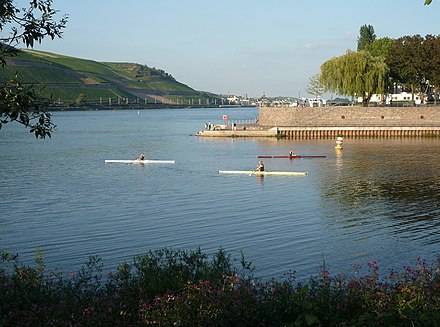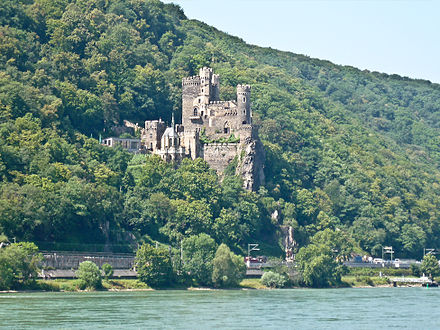Bingen - German town on the Rhine, home of the Mäuseturm
 Bingen am Rhein (pop 26,000 in 2020) is a town in the Rhineland-Palatinate region of Germany at the junction of the Rhine and the Nahe, across the river from Rüdesheim. It came into being as a strategically important location for the Romans.
Bingen am Rhein (pop 26,000 in 2020) is a town in the Rhineland-Palatinate region of Germany at the junction of the Rhine and the Nahe, across the river from Rüdesheim. It came into being as a strategically important location for the Romans.
Understand
Bingen was the home of one of the most incredible women in history, Hildegard von Bingen. It was here on the northern banks of the Nahe, that the Benedictine Hildegard von Bingen (1098-1179) founded her cloister upon the grave of the holy Rupertus. It is remarkable to note that in her "Physica", Hildegard von Bingen includes more than 250 plants and many folk remedies and "natural" medicinal methods of treatment. A scholar, artist, poet, preacher and composer (you can get CDs of her music at most major music stores), she was one of the most dominant and influential women of the Middle Ages (if she had been a man, she would have rivaled the Pope in influence). The Historisches Museum am Strom has an impressive display on her or you can also visit the Hildegard Forum, which has additional displays on Hildegard, including a restaurant that serves foods reflecting her nutritional teachings.
Get in
By train
There are two stations in Bingen on the West Rhine railway (Linke Rheinstrecke:) Mainz – Bingen Stadt – Bingen Hauptbahnhof – Koblenz – Köln (Cologne)
- Bingen (Rhein) Hauptbahnhof, 49.968779°, 7.884057°.
- RE 2 Koblenz – Boppard – Bingen (Rhein) – Mainz – Frankfurt (Main) Flughafen Regionalbf – Frankfurt (Main) Hbf
- MRB 32 Koblenz – Boppard – Oberwesel – Bingen (Rhein) – Ingelheim – Mainz
- RB 65 Kaiserslautern – Enkenbach – Winnweiler – Alsenz – Rockenhausen – Bad Münster am Stein – Bad Kreuznach – Langenlonsheim – Bingen (Rhein)
- Bahnhof Bingen (Rhein) Stadt, 49.96969°, 7.902725°.
- RB 35 Worms – Monsheim – Alzey – Armsheim – Gau-Bickelheim – Gensingen-Horrweiler – Bingen (Rhein) Stadt
- RB 80 Bingen (Rhein) Hbf – Bingen (Rhein) Stadt – Ingelheim – Mainz – Frankfurt (Main) Flughafen Regionalbf – Frankfurt (Main) Hbf
By car
The town is north of the Nahetal Dreieck, the A61-A63 interchange. The A61 provides a good connection from northern and southern Germany.
For a more scenic and slower drive, the B9 from Bonn provides a good way to see the Middle Rhine Valley.
From Hesse the car ferry (dead link: August 2018) from Rüdesheim is a recommended journey. Take the opportunity to get out of the car during the crossing for a great views of the river and valley.
By bus
see Intercity buses in Germany
By boat
- Bingen-Rüdesheimer (dead link: August 2018) cruise boat to/from Sankt Goar and Rüdesheim. They also operate a foot passenger ferry (dead link: August 2018) from Rüdesheim.
- The Köln-Düsseldorfer Rheinschiffahrt, better known as KD, runs cruises and scheduled services up and down the river between Cologne and Mainz, stopping in Bingen.
Get around
See

- Mäuseturm (Mouse Tower), 49.972036°, 7.880371°. Tower on island in the Rhine just down stream of the town. There has been some form of tower on the island for over a thousand year, the current one being build in 1855
- Burg Klopp, 49.966039°, 7.896771°. Remains of medieval keep but mainly more modern buildings. Now houses town administration and a restaurant.
- Historisches Museum am Strom, Museumstraße 3, 49.969522°, 7.892695°, +49 6721 990654. Hildegard von Bingen
Parks
- Kulturufer Bingen. Very nice view to Rüdesheim with the Niederwalddenkmal and the Rheingau.
- Hafenpark
- Hindenburgpark
- Rhein-Nahe-Eck − Museum am Strom, Hildegarten
- Park am Mäuseturm in Bingerbrück. This park close to the railway station and the Mäuseturm is also a really nice place to hang out along the Rhine river if you find yourself having some time left and/or waiting for the train. You also get a nice view to the Niederwalddenkmal.
Do
- Cycling
- Nahe Radweg. Bingen is the starting point of the Radweg Nahe, a 128 km posted bike route that follows the Nahe River southwest passed Idar-Oberstein to the source (or better the other way round).
- Hiwwel Route. 165 knm from Bingen to Worms
- Part of the Rhein-Radweg
- Hiking
Events
- Internationales Jazzfestival - Bingen swingt. Month: June. undefined
- Rhine in Flames: Rüdesheim - Bingen, Bingen. Month: early July. Experience seven magnificent firework displays, "burning" castles and an impressive illuminated fleet of more than fifty ships.
- Binger Winzerfest. Month: late August. An 11-day-long wine festival featuring wine tasting, an amusement park, a parade and fireworks.
Buy
Eat
- Zum Weinkeller, Vorstadt 60, 49.969131°, 7.899174°, +49 6721 1867994.
- Gaggianer, Badergasse 36, 49.967645°, 7.891681°, +49 6721 14882.
Drink
Sleep
- Hotel NH Bingen, Museumstraße 3, 49.969517°, 7.891345°, +49 6721 7960. Quality hotel on the banks of the river Rhine.
- Hotel Café Konditorei Köppel, Kapuziner Street 12, 49.967747°, 7.896131°, +49 6721 14770.
- Rheinhotel Starkenburger Hof, Rheinkai 1-2, 49.969272°, 7.895392°, +49 6721 14341.
Go next

Bingen am Rhein
bingen.deRhineland-Palatinate
Primary administrative division
Germany
deutschland.de/enPopulation:82.9 MDial code:+49Currency:Euro (EUR)Voltage:230 V, 50 HzIEC 60309